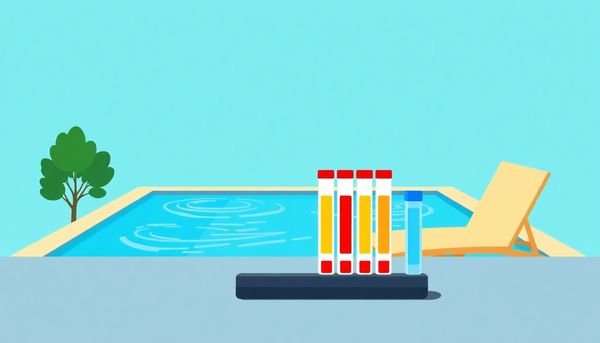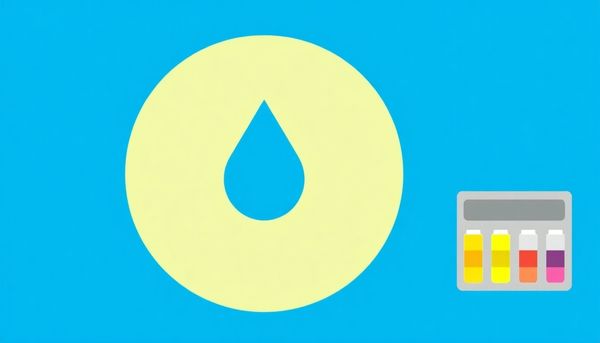Master Pool Water Chemistry: Essential Guide for Pristine Pools
June 10th, 2024
June 10th, 2024
On a warm summer afternoon, a sparkling pool can be the heart of a backyard oasis. Hosting family barbecues or simply lounging with a good book by the water, these moments are best enjoyed when your pool is in pristine condition. But maintaining that inviting blue hue and ensuring safe swimming conditions require more than just a casual glance at the water. It demands an understanding of pool water chemistry, a skill that many new pool owners find both crucial and perplexing.
Growing up, I watched my father test our pool water with an air of mystery, carefully measuring and adjusting various chemicals. It seemed complex, yet essential. Years later, when it was my turn to care for a pool, I realized that behind the apparent complexity lies a straightforward science that anyone can master with the right guidance. It's not just about keeping the water clear; proper pool water testing ensures health safety, extends the life of your pool equipment, and helps you avoid costly repairs.
This guide is designed to demystify the process, breaking down the essentials of pool water testing into manageable steps. From understanding pH balance and chlorine levels to interpreting test strip results, we aim to equip you with the knowledge necessary to maintain a safe and welcoming swimming environment. Whether you’re a seasoned pool owner or a newcomer, this journey into water testing promises to transform how you see your pool.

Unlocking the secrets of perfect pool water begins with mastering the art of testing. Imagine strolling down to your pool, confident in the knowledge that every component of your water chemistry is in check. It's not just about avoiding murky water or unsightly stains; it's about ensuring a safe, inviting aquatic haven for you and your guests.
The nuances of pool water testing go beyond the basics of chlorine and pH levels. Consider the silent troublemakers: phosphates, which could nurture algae, or metals like copper and iron, which may stain and damage your pool's surfaces. Each element plays a role in the overall health of your pool, and understanding their levels can save you from costly repairs down the line.
Regular testing isn’t merely a chore—it's a ritual. Weekly checks for pH and sanitizer levels, complemented by monthly screenings for metals, transform maintenance into a proactive practice rather than a reactive one. This diligence not only keeps your water sparkling but also extends the life of your pool infrastructure.
A friend once shared how a simple oversight in regular testing led to a summer of frustration with recurring algae blooms. His experience underscored the importance of frequent, comprehensive testing. Equipped with a range of tools from test strips to digital kits, maintaining the perfect balance might just be the easiest part of your day. Embrace this routine, and ensure your pool remains an oasis of relaxation and enjoyment.
Comprehensive chemical testing for pool water might sound like an intricate task, but it's more manageable than you might think. Consider the last time you stepped into a cloudy pool, unsure of what might be lurking beneath those murky waters. That unsettling feeling is a reminder of why thorough chemical testing is essential. Beyond just checking chlorine and pH levels, a complete analysis involves scrutinizing for phosphates, heavy metals, and calcium, among other things. Each of these elements plays a crucial role in ensuring both the aesthetic appeal and the safety of your swimming environment.
When I first started maintaining my pool, I leaned heavily on my local pool store for guidance. One insightful visit taught me that copper could be wreaking havoc on my pool liner, turning it greenish in spots. The source? My well water, rich in minerals. The lesson here was clear: understanding what's in your water before it goes into the pool can save you a lot of headaches.
Start by collecting a water sample from the center of your pool, avoiding areas near jets or skimmers. This ensures a representative assessment of your pool's overall chemistry. Then, employ test strips or liquid test kits to get a comprehensive view of your pool's health. Regular checks, perhaps biweekly during peak usage, will keep you ahead of any potential issues. By staying vigilant and informed, you're not just maintaining a pool; you're crafting a safe haven for countless sunlit memories.
As you bask in the delight of a pool shimmering under the sun, the last thing you want is a surprise attack from lurking contaminants. These sneaky intruders, like copper, iron, and calcium, don't just diminish your pool's sparkle but can also cause lasting damage. Imagine your pool liner marred by stubborn stains or your filtration system struggling under the weight of mineral deposits. Contaminant-induced damage often comes with hefty repair bills, so prevention is paramount.
To keep these culprits at bay, consistent and comprehensive water testing is your frontline defense. While most pool owners routinely check for pH and chlorine, expanding your toolkit to include tests for metals and hardness is crucial. A friend once found her pool mysteriously turning an unpleasant shade of green. The culprit? Copper, which had crept into her pool from her home's plumbing. Thanks to regular testing, she caught it early, saving herself from costly aesthetic repairs.
Once identified, addressing these contaminants isn't just about maintaining aesthetics; it's about safeguarding your pool's infrastructure. Employing metal sequestrants can prevent staining, while balancing pH levels mitigates the corrosion that often releases metals like copper and iron into your water. Regularly monitoring calcium levels also ensures that surfaces stay smooth and equipment remains efficient. By incorporating these practices into your routine, you not only preserve your pool's beauty but also its longevity, ensuring that every swim is as pleasurable as the first.
Keeping a pool in pristine condition is a bit like nurturing a garden; it requires regular attention and a systematic approach. First and foremost, establishing a consistent maintenance schedule is vital. Think of it as setting a date with your pool every week. This routine ensures issues are caught early, preventing them from becoming costly headaches later.
Consider incorporating a reminder system. Whether it's a digital calendar alert or a note stuck to your fridge, having a nudge helps maintain consistency. Start each session by skimming leaves and debris from the surface, followed by a thorough brushing of the walls and floor. This prevents algae buildup and keeps your pool looking inviting.
Investing in a quality pool vacuum can save time and effort. An automatic vacuum can do the heavy lifting while you focus on testing and balancing water chemistry. Speaking of which, always keep a well-stocked supply of test strips or a reliable liquid testing kit on hand.
Don't forget about your pool's filtration system. Regularly clean and inspect filters to ensure optimal performance. A clogged filter can turn your sparkling oasis into a cloudy mess. Make it a habit to check filter pressure weekly and clean or backwash as needed.
Lastly, enlist family members or housemates in the process. Assigning tasks not only lightens the load but also turns pool maintenance into a shared responsibility, making it less of a chore and more of a communal effort. Your pool will thank you, and so will anyone lucky enough to take a refreshing dip.

Water often hides secrets beneath its clear surface, making it essential to keep a vigilant eye on what lies beneath. While many pool owners focus solely on chlorine and pH, neglecting other potential contaminants could lead to unwanted surprises. Metals like copper and iron, though invisible at first, can become nuisances, discoloring water and surfaces, or even causing expensive damage over time.
Consider this: last summer, a friend noticed his pool losing its sparkle. A few tests later, he discovered excessive copper, a common culprit for green stains. The source was his tap water, which carried trace amounts of copper that accumulated with evaporation. By identifying the issue early, he avoided more serious problems with simple sequestrants and regular testing.
Metal detection isn’t the only priority. Calcium imbalances can lead to either scaling or etching, both of which are costly fixes if ignored. Regular testing for calcium levels ensures your pool’s longevity and keeps its surfaces safe and smooth.
In saltwater pools, the salt levels act as the backbone for chlorine production. Too little or too much salt can strain the chlorinator, leading to inefficient sanitation or equipment damage. A monthly check on salt levels, especially after heavy rains or water top-offs, keeps your pool’s chemistry balanced.
Investing time in understanding these elements transforms pool care from a chore into a proactive practice, safeguarding your oasis. Remember, consistent monitoring is your best ally in maintaining that inviting, pristine pool environment.
When considering the importance of keeping your pool water in pristine condition, comprehensive testing is an essential step that cannot be overlooked. Many pool owners become experts at checking the basics—chlorine levels and pH balance—but there's a world of potential issues lurking beneath the surface that can only be addressed through thorough testing. Elements such as phosphates, salt levels, and even metals like copper and iron can go unnoticed until they cause significant problems.
Personal experience taught me the hard way when my pool mysteriously developed unsightly stains. After a trip to the local pool store, I discovered elevated copper levels were the culprit. This episode drove home the importance of regular, comprehensive testing to prevent such headaches. Learning to monitor these factors not only helps maintain your pool's aesthetic but also prevents long-term damage.
Getting the most accurate results starts with taking the right sample. Think of it as a treasure hunt, where the treasure is a healthy pool: the key is in the sampling process. Avoid areas near the skimmer or return jets, and shoot for the pool's center where the water is well-circulated. From there, choose your testing method—strips for ease, or liquid kits for precision—and keep an eye on those less obvious parameters. A commitment to comprehensive water testing ensures your pool remains a source of relaxation and fun, not frustration.
Embarking on the journey of pool maintenance, one quickly realizes that effective testing tools are the unsung heroes in the saga of pristine waters. Remember that time you hosted a summer barbecue, only to find your pool water looking dull and uninviting? A simple oversight in testing could have been the culprit. Ensuring regular and accurate water testing is key to maintaining a healthy swimming environment and avoiding such mishaps.
In today’s tech-savvy world, you’re not limited to traditional methods. Digital testers have revolutionized the way we monitor pool chemistry. These gadgets provide precise readings for essential elements like chlorine and pH with minimal guesswork. Standing in stark contrast to the days of squinting at colored test strips, a digital tester gives you an instant verdict—no judgment, just facts.
For those who prefer a hands-on approach, liquid test kits remain a reliable option. Perhaps you find satisfaction in the drop-by-drop anticipation, watching the solution’s hue reveal your pool's chemical secrets. Armed with phenol red for pH and orthotolidine for chlorine, these kits offer a tactile connection to your pool's well-being.
Don't forget the niche elements like phosphates or heavy metals. Specialty test strips can alert you to these sneaky intruders, ensuring your pool is not just clear but truly clean. Armed with the right tools and routine, you can confidently maintain your pool, ensuring every swim is a dive into crystal-clear perfection.
Ensuring that your pool remains a safe oasis requires more than just regular water testing—it's about implementing comprehensive contaminant-prevention strategies. Over the years, I've discovered that swift attention to potential contaminants not only saves time, but also prevents costly repairs. Think of it like maintaining your car; a little prevention goes a long way.
To start, always monitor the pool’s environment. Fallen leaves, dirt, and twigs can introduce unwanted phosphates and metals into the water. Skimming the pool daily and regularly cleaning the surrounding area can mitigate this. If you frequently host pool parties, consider installing a cover when the pool is not in use to minimize debris ingress.
Investing in a high-quality filtration system is another game-changer. A good filter will trap contaminants before they settle, maintaining clarity and reducing the strain on your chemical treatments. Make it a routine to clean and backwash your filter as required, ensuring it operates at peak efficiency.
Additionally, routinely balance the water chemistry. Keeping pH and alkalinity in check prevents metal corrosion, which can introduce copper and iron into the water. Implement the use of metal sequestrants to bind metals, preventing them from staining pool surfaces, though remember these need regular replenishment.
Lastly, engage in proactive communication with your local pool supply store. They can provide insights specific to your regional water quality, offering solutions to potential issues before they escalate. By weaving these strategies into your maintenance routine, you'll ensure a pool that's not only welcoming but also long-lasting.

Balancing the chemistry of your pool is akin to crafting the perfect recipe; each component needs to be measured precisely to achieve that pristine, inviting water. Begin with the basics: maintain the pH level between 7.2 and 7.6 to ensure swimmer comfort and effective chlorine disinfection. A personal reminder from a summer past: neglecting this balance led to a pool party cut short by irritated eyes and skin. It’s worth the diligence.
Next, stabilize your alkalinity, ideally between 80 to 120 ppm. This acts as a buffer for pH levels, preventing sudden fluctuations. I recall a time when my pool’s alkalinity dipped, resulting in an unexpected rollercoaster of pH levels and constant monitoring. Lesson learned—the hard way.
Chlorine, the defender against bacteria and algae, should hover around 1 to 3 ppm. Too little, and you invite a murky menace; too much, and you risk that unmistakable bleach odor. I once overcorrected after a rainstorm, only to watch my backyard oasis become a chemical-smelling swamp—definitely a tale to avoid repeating.
Finally, don't overlook calcium hardness, which should remain between 200 to 400 ppm to prevent scaling and corrosion. In hard water regions, I’ve found adding a bit of calcium increaser post-refill helps maintain harmony. Regular testing and adjustments can save you from costly repairs and ensure every swim is a refreshing retreat.
When you're planning a relaxing day by the pool or a lively pool party, the last thing you want is to encounter murky water or unexpected chemical mishaps. Conducting accurate water testing is your first line of defense against these aquatic woes. The secret lies not just in testing, but in testing correctly.
Start with the water sample. Rather than skimming the surface, plunge a bit deeper and collect from the center of the pool, away from return jets or the skimmer, where chemical levels might be skewed. This ensures a true representation of your pool's chemistry. Forget the old days of relying solely on chlorine and pH tests; modern pool care demands more. Think phosphates, calcium, and even metals like copper and iron.
Test strips are your quick go-to, offering an immediate snapshot of your pool’s wellbeing. They are especially handy because they reduce the chance of human error. However, for a more detailed analysis, liquid test kits remain invaluable. Remember to inspect the colors against a white backdrop for better accuracy.
Routine is key. Weekly tests can catch shifts in pH and chlorine levels, but keep an eye on those surprise summer rainstorms or extra splashy playtimes, which require additional checks. And while you may feel like a seasoned pool chemist, a professional test at the pool store once a month never hurts. It's maintenance in advance, saving you from costly repairs later.
The shimmer of a perfect pool can quickly tarnish if metal contamination sneaks in unnoticed. Imagine the surprise of diving into what you expect to be a refreshing escape, only to find unsightly stains or murky water. Metals like copper and iron are often the culprits, silently introduced through well water, municipal supplies, or even eroding pool equipment. When left unchecked, these metals not only mar the appearance of your pool but can also wreak havoc on its structural integrity.
To combat this, regular testing for metal contaminants is crucial. While standard test strips often miss metals, specialized kits are both affordable and effective. These kits can identify even trace amounts, giving you a head start on addressing any issues. Take, for example, my own backyard pool: a simple monthly test revealed elevated copper levels, sparing us from potential staining nightmares.
Once detected, metal sequestrants can be your ally. These compounds bind with metals, preventing them from oxidizing and staining. However, remember that sequestrants don’t remove metals—they simply neutralize their negative effects. For a more thorough clean, consider using a metal trap filter, which physically removes metals from the water.
By staying vigilant and proactive with testing, you can keep your pool's water pristine and inviting. It’s an approach that saves time, money, and the frustration of unsightly surprises, ensuring your pool remains the tranquil oasis you intended.
When it comes to maintaining the pristine allure of your saltwater pool, getting that salt balance just right is a task that deserves your undivided attention. Salt might seem like a simple ingredient, yet its role in your pool's ecosystem is anything but trivial. For those who have embraced the luxury of a saltwater pool, understanding and managing salt levels can make all the difference in pool maintenance.
Salt levels that wander too far from the ideal range can disrupt your pool's delicate balance. In my own backyard oasis, an overzealous salt level sent my chlorinator into overdrive, resulting in frustration and a lesson learned the hard way. Conversely, insufficient salt hampers the chlorinator's ability to produce chlorine, potentially compromising the cleanliness and safety of your pool water.
Your target is a sweet spot: around 3,200 parts per million (ppm) of salt. Specialty test strips are your best ally for this task. A simple dip and wait of 20 seconds can reveal whether your pool's salt content is on point. Testing monthly usually suffices unless a sudden rainstorm or fresh water addition demands a re-check.
Should your salt levels soar too high, the solution is rather straightforward. Drain a portion of your pool water and replace it with fresh to dilute the salt concentration. On the flip side, if salt levels are too low, the fix is as easy as sprinkling a bit more salt into the mix. With these steps in your pool care repertoire, you can ensure your saltwater pool remains a sparkling haven throughout the season.

Selecting the perfect test kit for your pool is like choosing the right tool for a DIY project—it can make all the difference. Each pool has its own personality and needs, influenced by factors like location, usage, and water source. While you might be tempted to grab the first kit you see on the shelf, investing a bit of time in understanding your pool’s unique requirements will pay off in crystal-clear dividends.
Start by considering the basics: chlorine and pH levels. These are the bread and butter of pool maintenance. A basic test strip kit will suffice for regular checks, offering convenience and quick results. However, for those dealing with more complex issues like cloudy water or stubborn stains, you’ll need a kit that includes tests for metals such as copper and iron. These metals often hitch a ride into pools via well water or corroded plumbing, and if left unchecked, can wreak havoc on your pool’s aesthetic and infrastructure.
For saltwater pool owners, salt level testing is crucial. Some kits come with strips specifically designed for salt, ensuring your chlorinator functions efficiently. Remember, too much or too little salt can upset your pool's balance.
Opt for digital testers if precision is your priority. These gadgets eliminate guesswork, providing digital readings that are easy to understand. Although a bit pricier, they can save time and reduce errors, making them a worthwhile investment, especially for tech-savvy pool owners or those with large pools.
Ultimately, choosing the right test kit involves understanding your pool’s specific needs and your personal preferences. A well-chosen kit not only simplifies maintenance but also ensures your pool remains a sparkling oasis.
So you’ve got your sun hat, a cold drink, and the perfect novel in hand. But before you jump into those long afternoons by the pool, there’s a crucial step: understanding your testing options for maintaining pristine pool water. It's not just about chlorine and pH; there's a whole symphony of elements that demand your attention.
Testing your pool water can be likened to conducting a weekly health check. Test strips are the quick check-up option—economical and straightforward, they deliver results in seconds. I remember the satisfaction of watching the colors transform on the strip, a science experiment right in my backyard. Strips are perfect for regular checks of pH and chlorine, but for the full spectrum—think metals like copper and iron—you'll need more precise tools.
Liquid test kits offer a deeper dive. They require a bit more time and care but reward you with detailed insights into your water chemistry. My first attempt with a liquid kit felt like a mini chemistry class. Careful measurement and color comparison are key, and there's a certain satisfaction in mastering it.
If you're a tech enthusiast, digital testers could be your best friend. These gadgets take the guesswork out, providing digital readouts that make data easy to understand and act upon. Whether you prefer the simplicity of test strips or the precision of digital readers, knowing your options empowers you to keep your pool inviting and safe for all your summer escapades.
In the world of pool maintenance, the art of accurate sampling holds the key to a summer of sparkling waters and worry-free swims. Imagine standing by your pool, test strip in hand, and the peace of mind that comes with knowing your efforts will yield precise results. It all begins with that small, crucial scoop of water.
First, consider the location. Avoid the temptation to gather water from areas close to skimmer openings or return jets. These spots can skew your results due to localized chemical concentrations. Instead, aim for the pool's heart—the center. By doing so, you capture a true representation of your pool’s overall health.
Next, think about timing and technique. Early morning or late afternoon, when the sun's rays are gentler, is the ideal time for sampling, as this avoids chemical fluctuations caused by heat. Submerge your container elbow-deep, scooping the water with a gentle, sweeping motion to avoid surface debris. This technique ensures a clean sample that mirrors the pool's current state.
In my own experience, I once faced murky waters despite regular testing. It turned out I was sampling too close to my pool’s filter return. A simple shift in approach revealed the true chemistry, allowing for swift adjustments and a return to pristine conditions.
By prioritizing accurate sampling, you lay the groundwork for effective pool management. Understanding your water’s story from each scoop helps maintain balance, prevent issues, and keep your pool party-ready all season long.
Stepping into the world of pool maintenance, one quickly discovers the art of water testing is pivotal. The key to a sparkling pool lies in choosing the right test kits, which can feel like navigating a maze with the plethora of options available. Consider this: not all test kits are created equal. Opting for a comprehensive kit that not only covers the basics like chlorine and pH but also checks for lesser-known culprits like phosphates and heavy metals is a savvy move.
Reflecting on personal experiences, a friend who initially relied solely on basic test strips realized their oversight when stubborn algae and staining appeared. This underscores the importance of selecting kits that offer a complete analysis, preventing headaches down the line. Generally, liquid test kits offer precision, yet require a bit more finesse in handling. They are excellent for those who prefer accuracy and don’t mind the extra step of color matching.
On the other hand, digital test kits are perfect for tech enthusiasts. These devices simplify the process, providing digital readings that eliminate guesswork. Investing in a digital kit can be particularly beneficial in areas with complex water issues, offering peace of mind with every splash. Ultimately, your choice should reflect your needs, pool type, and local water characteristics. Selecting effective test kits ensures not just a clear pool, but a safe and enjoyable swimming season.

The anticipation of a refreshing plunge is quickly dashed when you notice unsightly metal stains marring your pool's pristine surfaces. Metals like copper and iron can sneak into your pool through various sources, turning your dreamscape into a maintenance nightmare. Combatting these stains requires knowledge and proactive measures.
Start by understanding how these metals find their way into your pool. Copper, for instance, is commonly introduced through the source water; whether it's from your garden hose or a nearby well, metals can accumulate over time as water evaporates, leaving minerals to linger. Iron often follows a similar path or enters through corroding metal components in pool equipment. Regularly testing your source water can help identify if these offenders are present before they become a larger issue.
Prevention is the most effective strategy. Begin by incorporating a metal sequestrant into your pool maintenance routine. This liquid binds with metals in the water, preventing them from oxidizing and causing those tell-tale stains. Although sequestrants don't remove metals, they do keep them suspended, reducing the risk of staining. Remember, consistent application is key, as the sequestrant breaks down over time.
Additionally, consider using a specialized metal trap filter. Unlike your regular pool filter, this device is designed to capture metals specifically, offering an extra layer of protection. For those filling pools with potentially metal-laden water, a hose filter can be a simple yet effective tool in keeping metals at bay from the get-go.
By incorporating these strategies and staying vigilant with regular testing, you can enjoy your pool without the headache of persistent metal stains. Your pool's clarity and your peace of mind will thank you.
Opening your backyard oasis for long, sunlit days can be a delight, provided your pool is as prepared as you are. The key to ensuring that your pool water is as pristine as it appears lies in the routine habit of water testing. This isn't just about maintaining blue water; it's about ensuring safety, preventing damage, and making sure your investment remains enjoyable.
Think of pool water testing as a regular health checkup for your aquatic retreat. Simple tests for chlorine and pH levels are just the beginning. Beyond these, keeping an eye on phosphates, salt levels (for saltwater pools), and potential heavy metal contaminants like copper and iron is crucial. These elements, if unchecked, can lead to unsightly stains, cloudy water, and can even harm pool equipment.
Consider the scenario of planning a pool party. You don’t want guests to find green, murky water or suffer from any skin irritations. By establishing a habit of weekly testing, you catch imbalances before they escalate into larger problems. Personal experience tells me that a quick test before a busy weekend has saved more than one gathering from aquatic disaster. Ensuring you have a reliable set of test strips or a liquid test kit at hand means you're always ready to act.
Regular testing isn't just about adding chemicals when things go awry but about understanding your pool's unique ecosystem. This proactive approach ensures your pool remains a haven of relaxation, free from the worries of unexpected surprises.

This article provided insights into maintaining your pool. Start your pool care journey today!
Want to become a pool maintenance expert? Our free Pool School course covers everything you need to know about pool care. From basic maintenance to advanced troubleshooting, you'll learn how to:
Join over 10,000 pool owners who have already transformed their pool care routine. Get started with our free Pool School course today!